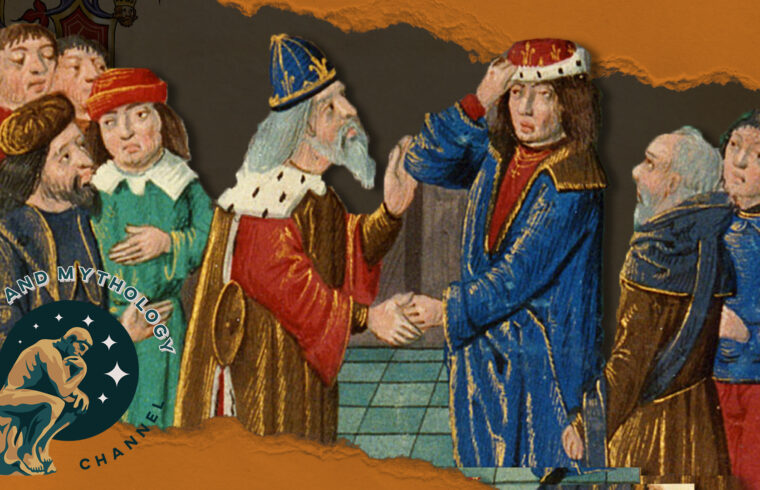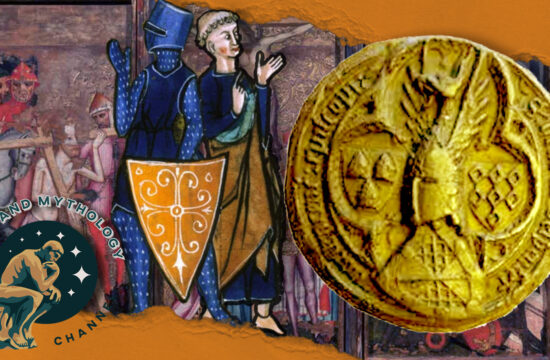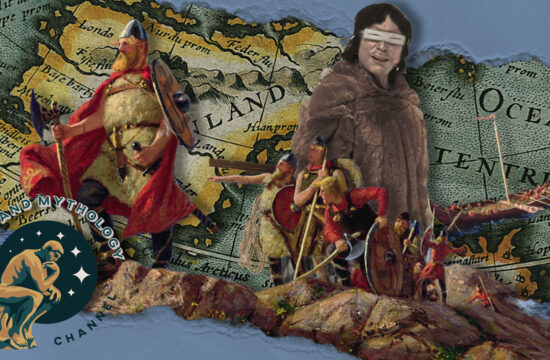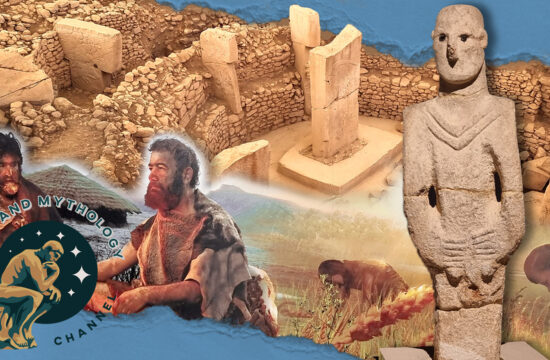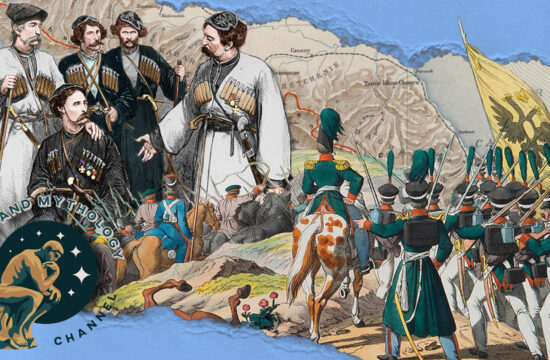The two extremities of Europe. Two powerful Medieval realms: the Byzantine or Eastern Roman Empire and England. Divided by space but both being Christian polities, the two never lost contact. What were the connections between England and the lost Empire of Constantinople in the Medieval millennium? We’ll find out in this video of the History and Mythology channel.
Hi, this is History and Mythology and we talk how did England and the Byzantine Empire see each other during the Middle Ages!
They didn’t meet often but they still met. After all, they were on the two opposing sides of the continent. They certainly knew of each other. And as I will try to show here, their relations were usually respectful, even friendly.
First and foremost, Constantine the Great, the founder of Constantinople, was first proclaimed Emperor in Britain.
The Anglo-Saxons mentioned the Byzantines in “Widsith” (as Greeks) and in Venerable Bede’s “Ecclesiastical History of the English People” (as both Romans and Greeks). Some Anglo-Saxon Kings used Byzantine titles for themselves (like Edward the Confessor styling himself a “basileus” in the 11th century).
Of course, Romans or Byzantines knew that Britain had once been a Roman province and knew about its many nations: Britons, Saxons, Angles, Frisians, Picts and Scots. Procopius of Caesarea mentioned a part of these populations in his historical works in the 6th century.
A Byzantine Greek monk ended up as an early Archbishop of Canterbury: Theodore of Tarsus who spent more than 20 years in Kent being the Archbishop in 668–690.
Anglo-Saxon pilgrims must have met Byzantines in Rome before the East-West Schism started in 1054. There were “schools”, that is, houses for English and Greeks in Rome.
After the Norman Conquest of 1066 a part of Anglo-Saxon and/or Anglo-Danish exiled and self-exiled nobility ended up in Constantinople as Byzantine mercenaries. Some of these people might have reached Crimea and even founded an English community there with the blessing of Byzantine Emperor Alexius I Comnenus if we believe the Late Medieval “Saga of King Edward” and the “Chronicle of Laon” about the adventures of the so-called Earl Siward of Gloucester.That’s confirmed by Geoffroy de Villehardouin, the Marshal of Champagne who chronicled the failed Crusade and served the Latin Emperors of Constantinople.
By 1176 French poet Chrétien de Troyes wrote “Cligès”, a fantastic French romance in verse telling the story of a young Byzantine prince, the son of of a former Emperor of Constantinople, who got his rightful throne with the help of British King Arthur. Chrétien was maybe slightly related to the Anglo-Norman court as he served Marie of Champagne, a daughter of English Queen Eleanor of Aquitaine from her first marriage. Byzantines in this work are represented as perfectly compatible with their Western counterparts.
In 1191 Richard I of England, the Lionheart, had extensive contacts with the Byzantines as he had to secure the Byzantine island of Cyprus as a base for his crusading attempt at recovering Jerusalem. He fought against a local Greek usurper named Isaac Comnenus/Komninos and had to keep some diplomatic relations with the Emperor in Constantinople, another Isaac.
Somewhere around 1236–1253 English monks and scholars Matthew (of) Paris, John of Basingstoke and Robert Grosseteste were great proponents of Greek scholarship and teachers in Greek language in the University of Oxford. They knew each other and were actually friends. Matthew was mainly a historian. John was a translator from Greek and somewhat of a mystic and theologian. Robert took several influential positions and eventually became Bishop of Lincoln. He also wrote several treatises on physics, astronomy and optics. Robert and John translated the so-called “Testament of the Twelve Patriarchs” from Greek. This prophetic text was brought directly from the East in the aftermath of the 4th Crusades’ Sack of Constantinople. Robert translated and commented works by Aristotle (his “Ethics” and the second “Analytics”) and St Dionysius’ or rather Pseudo-Dionysius’ “Celestial Hierarchy”. Matthew Paris claimed that John of Basingstoke had been instructed in Greek language and philosophy by the former Metropolitan or Archbishop of Athens, Michael Choniates, a relative of Byzantine court official and writer Nicetas Choniates somewhere between 1205 and 1220. There’s also the curious story about Constantina, the daughter of the Archbishop, who was described as a learned, virtuous and beautiful young Greek lady helping her saintly father in instructing the English scholar aspiring to knowledge. Talk about Boethius’ Lady Philosophia!
In 1268–1274 the future Edward I of England was on a Crusade in the East. He reached Cyprus and Syria just some years after the Byzantine Empire was restored by Michael VIII Palaeologus and the end of the Latin Empire of Constantinople in 1261. Yet, Edward had no important relations with the Byzantines. He was interested in helping the (Jerusalem) Kingdom of Acre survive the Muslim and Mongol onslaught while the Byzantines were busy on the Balkans and in the Western part of Anatolia. They had no points of conflict nor any common interests but the Byzantines were probably well informed and maybe even curious about Edward’s presence in the Eastern Mediterranean. The interesting speculations about the hypothetical planning of Caernarfon castle after the model of the Constantinople Theodosian walls may still deserve some attention. But Edward never visited Byzantium, so he might have been inspired by some other, similar Roman fortifications in the East.
Of course, the English representatives at the 1274 Council of Lyons must have seen the Byzantine delegates.
In 1400, the Byzantine Emperor Manuel II Palaeologus visited England and was royally entertained by Henry IV. In his “Fall of Constantinople” Steven Runciman quoted Adam of Usk’s “Chronicle” about this moving Christmas visit. It was a part of a desperate Byzantine plan of gathering Western help against the Ottoman Turks. The English court was friendly, sympathetic and polite to the Greeks, and some money was offered to the Emperor. It’s possible that someone remembered in front of the two monarchs that Constantine the Great was proclaimed Emperor in Britain. Maybe even some knights might have offered their service to the Greek ruler with King Henry’s agreement. Four years earlier, in 1396, some English knights had participated in the disastrous battle of Nicopolis which brought the final Ottoman blow against the vestiges of any Bulgarian self-rule on the Balkans and caused fear in Constantinople.
The 1414–1418 Council of Konstanz/Constance in Germany was visited once more by representatives both of England and the Eastern Empire. Many Eastern priests and other learned men were present, both Catholic and Orthodox, from traditionally Orthodox countries like Rus and Wallachia. The English mission concluded a concordat with the Papacy on July 12th 1418. Byzantine diplomat Manuel Chrysoloras died during the council sessions in 1415 and was buried in the same Konstanz. Back in 1404 he had been the ambassador to England for his master and namesake, Emperor Manuel II (the same who had visited Henry IV in 1400). So Chrysoloras who had extensively traveled through Western Europe and already knew the English court might have been motivated to contact the English once again.
Finally, in 1435, Sir Robert Malory, the English Prior of the Knights Hospitaller traveled to the Isle of Rhodes in order to participate in a Chapter-general of his Order and help in the preparations for an expected Ottoman attack. The Isle was (and still is) inhabited by Greeks and had some trade relations with Constantinople, Byzantine Morea and the Venetian and Genoese islands in the Aegean Archipelago. Sir Robert might have had some contacts with Byzantine subjects or at least with Greek-speakers. Other English Hospitaller knights and secular c onfratres of the Order were present as well. In 1438–39 Sir Robert was on his way back to England and visited the Ferrara-Florentine church Council in Italy. There was present the Byzantine Emperor John VIII Palaeologus who was once more seeking the help of the Papacy and of any Western European power against the Turks. It’s possible for Sir Robert to have been present at some of the negotiations with the Byzantines because he was acting as an English ambasador as well. He might have even seen the Emperor. Now, Robert Malory was the uncle of well-know Arthurian writer Sir Thomas Malory of Newbold Revel, the author of the famous “Le Morte d’Arthur” which was printed by William Caxton in 1485. In his romance, Thomas wrote that some of the last surving knights of King Arthur went to the Holy Land and fought the Turks. He might have been inspired for that anachronism by the travels of his uncle Robert. Sir Thomas’ modern biographer Christina Hardyment even claims in her well-written but highly speculative book “Malory: the Life and Times of King Arthur’s Chronicler” that a young Thomas had accompanied Sir Robert to Rhodes and back.
Somewhere between 1453 and 1470 Greek post-Byzantine writer Michael Critobulus of Imbros dedicated his history of the fall of the Eastern Empire to the victorious Ottoman Sultan Mehmed II and claimed that as the book is written in Greek, it could be read by people from East to West, and even in Britain. He was obviously quite optimistic on the ability of Late Medieval English readers to read his language.
And, of course, there was a slightly Byzantine moment in the coronation of Charles III. Capella Romana sang Psalm 72 (KJV) in Greek when the King received the Sword of Offering. That was done in memory of late Prince Philip, the King’s Greek father. A nice touch.

